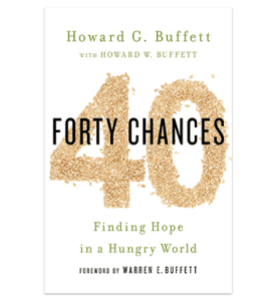It’s been awhile since I’ve read a book that wasn’t written by Dr. Seuss, titled “Little House . . .” or chronicled the adventures of Junie B. Jones. But when 40 Chances arrived in my mailbox, I scheduled time to read it, digest it and consider its lessons.
40 Chances: Finding Hope in A Hungry World by Howard G. Buffett (remember the ‘G’ because his son, Howard W. Buffett also contributes to the book) is a terrific look into the mind of a futuristic thinker, an entrepreneur with a philanthropist’s heart, and a farmer who manages a foundation dealing in billions of dollars. The latter underscores the futuristic thinking, but does not take away from the overall lesson. Regardless if we’ve been given a billion dollars to fight a cause or if we’ve just been given a life on this planet, we have a responsibility to do better today than we did yesterday. You don’t need a billion dollars to be a better farmer. You just need the heart and brain that God gave you.
The concept of 40 Chances was introduced to Mr. Buffett at “Planter’s School” offered by Sloan Implement Co. down in southeast Illinois. A speaker challenged a small group of farmers to consider how many seasons they would have to plant and harvest a crop. “You’ll get forty chances to plant your crop, adjust to what nature throws at you, and hope for the best. It’s enough time to learn to do well. But it’s not forever.”
And this is where the son of Warren Buffett, father, husband, and Decatur, Illinois farmer begins his trek through forty stories about farmers, dictators, war, poverty, mal-nutrition, hunger, soil conservation, water quality, culture, politics, and hope. Above all, hope. Mr. Buffett profiles amazing people who are using their heart, brain and ambition to get things done where others have failed.
I expected 40 Chances to be all about farming. After all, my exposure to The Howard G. Buffett Foundation has been through agriculture magazines with whole sections focusing on soil conservation. I wasn’t prepared for the in-depth look at political and cultural crisis that grip so many people. His experiences in Africa with former child soldiers, families ripped to shreds by civil war and children swollen with hunger are hard to read and even harder to fathom. But these situations are very real and have a very real impact on the current first world trend of sustainability.
Mr. Buffett makes it clear: the efforts to farm sustainably must address the situations of ALL farmers. His stories push us past our own fence rows and into the life of subsistence farming.
The book clearly has messages for various groups of people.
For philanthropists, community volunteers and nonprofit supporters: Mr. Buffett asks this question “What is your strategic plan for going out of business?”
Think on that.
As a member of our local United Way board of directors, I found myself considering the work of so many of the agencies we support. Awesome agencies powered by amazing individuals who work hard to make a difference. But if they are always working hard to make that difference, is any change really happening?
It’s just a question. A unique perspective. If we approached community problems with the mind-set that one day we should go out of business, would that change how we approach an issue?
For those concerned with food security: Mr. Buffett spends a lot of time discussing the ins and outs of hunger around the world with a laser focus on developing countries. However, his storytelling illustrates that food insecurity takes many forms and is found on many faces. It doesn’t always scream, “Hey, I’m hungry!” and it is very present in our own backyards.
He identifies that politics, culture and infrastructure can impede a farmer’s ability to be successful at not only providing for his/her family but contributing to his/her community’s economy. He forgoes placing blame on agribusiness for the lack of improvement in developing countries’ agriculture communities. Instead he writes much about NGOs. The bureaucracy that governs so many of these well-meaning organizations only further highlights Mr. Buffett’s ability to think outside the box to find unconventional solutions for what has become traditional problems.
For farmers: The message is all about soil. How do we save it, improve it and use it sustainably. Mr. Buffett acknowledges that a variety of conservation practices employing a variety of farming techniques (organic, conventional, gmo, etc.) will be necessary to ensure our future. He clarifies this as an issue that must be addressed by all farmers – corn, cotton, organic, vegetable, small-holder farmers and thousands-of-acres farmers. We all must live up to the title “stewards of land” whether we cultivate with a horse, a hoe or a GPS-guided, auto-steer tractor.
For anyone who feels they deserve to have an opinion – informed or otherwise – about modern agriculture and food production: I’m not sure how anyone can walk away from these forty stories without full appreciation for diversity in agriculture and an understanding of the necessity to explore all opportunities that will help us learn about soil, plants, animals and our environment. Mr. Buffett writes over and over about how a one size fits all approach will NEVER truly feed the world. NEVER.
It would be easy to dismiss 40 Chances as yet another ‘seize-the-day’ memoir written by someone who has had every fully funded opportunity to follow his dreams. But, not once did I find myself focused on his name – Buffett – or his family’s legacy. Instead, I think I found my kindred spirit in Howard G. Buffett . . . an individual determined to do better because it is the right thing to do.
Read another 40 Chances review by The Foodie Farmer.





Leave a Reply